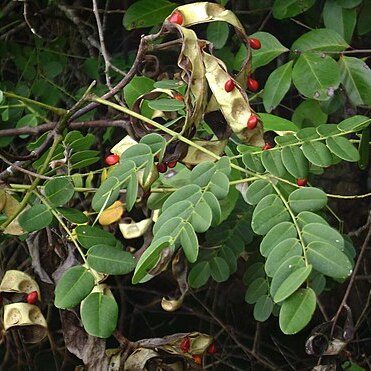Trees, unarmed. Leaves bipinnate, spirally arranged, without glands; stipules caducous, small; leaflets alternate, in many pairs, small. Inflorescence a raceme or panicle, axillary or terminal. Flowers white or yellowish, bisexual or polygamous, shortly pedicellate. Calyx campanulate, shortly 5-toothed. Petals 5, lanceolate, coherent below middle or soon free. Stamens 10, free, slightly longer than petals; anthers ovoid, with a deciduous gland at apex. Ovary sessile, many ovuled; style filiform. Legume straight, falcate, or slightly twisted, strap-shaped, leathery, septate between seeds, dehiscent along sutures when ripe. Seeds thick; testa scarlet or 2-colored, hard, with pleurogram, mostly enclosed by a thin pulp.
Trees, unarmed. Leaves bipinnate, pinnae with several to many pairs of alternate leaflets. Inflorescences of spiciform racemes which are axillary, solitary or sometimes paired, often aggregated at shoot-ends. Flowers normally hermaphrodite. Calyx gamosepalous, ± 5-toothed. Petals 5, free except near base. Stamens 10, fertile, free except at extreme base; anthers with a caducous apical gland. Pods linear, curved or spirally twisted, longitudinally dehiscing at maturity into 2 coriaceous or subcoriaceous valves which do not separate from the sutures nor lose their outer layer (exocarp). Seeds thick, hard, red or red and black.
Trees. Leaves bipinnate; stipules inconspicuous or filiform; leaf axes lacking extrafloral nectaries; pinnae 2-5-jugate, subopposite to opposite; leaflets petiolulate, 6-16, subopposite to alternate. Inflorescence axillary spikes or racemes near branchlet tips, solitary or fasciculate, pedunculate. Flowers 5-merous, bisexual, borne on short, jointed pedicels with basal part persistent; calyx and corolla valvate, each basally connate. Stamens 10, free; anthers with stalked, caducous, apical gland. Pod linear, straight to twisted; valves coriaceous or woody. Seeds scarlet, red or red and black; pleurogram absent.

